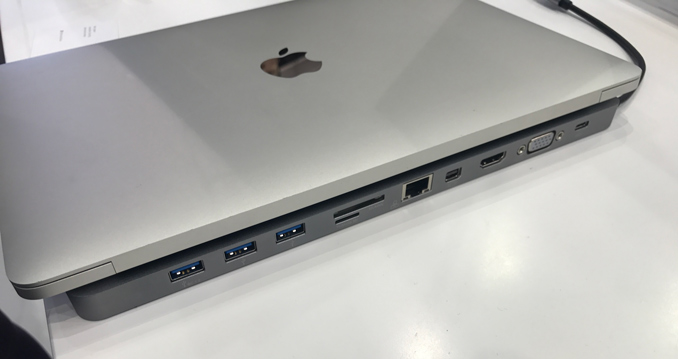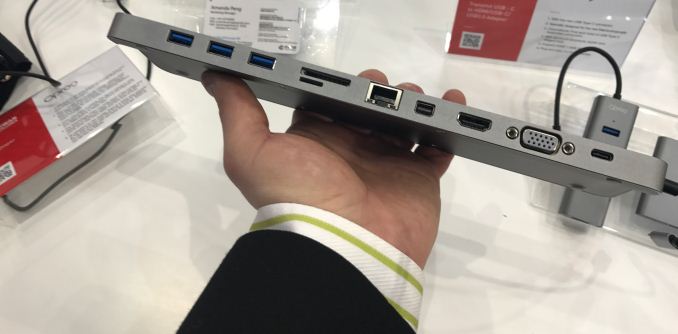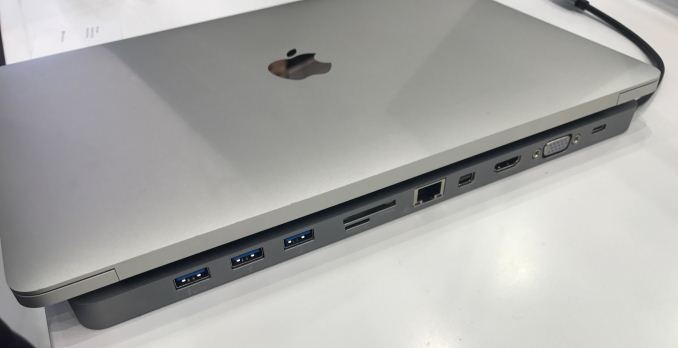Opro9 Introduces USB-C Dock & Adapters: from €29 to €109
by Anton Shilov on March 9, 2018 2:00 PM EST- Posted in
- Peripherals
- Trade Shows
- USB-C
- MWC 2018
- Opro9

Opro9 may not sound like a household name, but this company introduced a lineup of USB Type-C adapters and a docking station that feature rather interesting configurations, and at prices that do not break the bank.
Primarily due to lack of USB Type-A headers and display outputs on the latest MBPs and other ultra-slim laptops, demand for various multi-port adapters and docking stations featuring USB Type-C or Thunderbolt 3 headers is accelerating. Historically, such devices were used by professionals for rather specialized use cases, which is why they have always been quite expensive (think of volumes). Meanwhile, since demand for these products is growing, manufacturers can sell them at lower margins while increasing volumes. Apparently, this is exactly why it makes sense for newer entrants to reach this market with their products and this is exactly why companies like Opro9 are rolling out their adapters and docking stations.
Opro9’s family of USB Type-C devices contains three products.
- The first one features a USB Type-A port, one DisplayPort 1.2, and one additional USB-C connector (this one makes a lot of sense for use Apple’s MacBook that has only one USB-C port).
- The second one features three USB Type-A ports and a GbE header. This one seems to be aimed at users in the enterprise space who need Gigabit Ethernet.
- The third one provides everything one may way want: three USB Type-A ports, two card readers (for SD and microSD cards), a GbE header, an HDMI output, a mini DisplayPort and one more USB Type-C header.
Meanwhile, important things about these products are their prices. The former two adapters cost 29 – 49 Euros, whereas the docking station is priced at 109 Euros. Some might say that it is expensive because the said ports have to be present in all laptops. I would argue. One physical interface for everything (power, display, data, etc.) on personal computers is what the industry needs and USB Type-C and Thunderbolt is simple to use and fast. If you need something else, you unfortunately have to pay for this, in the end it is impossible to have all kinds of ports on ultra-thin laptops. Prices of docking stations and adapters are not low, but Opro9 gives you an option to pay a bit less when compared to products from other companies.
Related Reading:
- Kingston at CES 2018: Nucleum, a Portable 7-in-1 USB-C Dock for Notebooks
- AUKEY’s CB-C55 USB-C Hub Now on Sale: Macbook Port Expander with Power and Ethernet
- Lenovo’s New ThinkPad Laptops Get Universal USB-C Power Adapters
- Lenovo Reveals New TB3 Powered Graphics Dock at CES 2018: GTX 1050, 90 Hz WMR
- OWC Launches 13-Port Thunderbolt 3 Dock: GbE, USB-A, SD Card, mDP, FireWire & More
- Promise Launches TD-300 9-in-1 Thunderbolt 3 Dock: GbE, HDMI, USB 3.0, TB3 Charging & More
Source: Opro9












7 Comments
View All Comments
HStewart - Friday, March 9, 2018 - link
As an owner of both Dell XPS 13 2in1 and Samsung TabPro S ( and likely a Dell XPS 15 2in1 or new 8th Gen Dell XPS 15? (6 core??) I find a couple of things important with USB-C docks1. Pass through USB-C Power ability is extremely important
2. I would love for the docks to work the same on each computer.
3. Thunderbolt 3 support is important to me now
I have issue with getting docks to work with both the Dell and XPS. I have settle on Dell TB-16 Doc for my Dell - and have Samsung USB-C adapter ( with HDMI and USB 3 ) for the Samsung
I believe the TB-16 should work with Dell XPS 15 2in1 in which I hope to get - or if possible Dell release a new XPS 15 with rumor Intel 6 core mobile CPU. I might have to purchase a 240w external power supply for TB-16
I also have a Chuwi HiPro 8 that is USB-C - but honestly it pretty much a piece of junk for $100 but also has USB-C for power and connection.
arne.klein - Saturday, March 10, 2018 - link
Same here. I have a Dell Latitude 5289 and a Lenovo ThinkPad X1 Tablet, and I got an Anker USB-C Dock with USB Power Delivery, HDMI (via Display Port Alternate Mode) and USB-A.It works well on the ThinkPad (which is why I bought it).
Different story with the Latitude though. USB-C Power Delivery works only with the Dell charger (not with any other), very unreliably at that, and if it does, HDMI doesn't work. Without USB-C PD, HDMI works fine, but plugging in the Dell charger into the dock has no effect then.
Even the Dell USB-C docks have all sorts of issues (unreliable network, flaky DusplayPort connections with picture that intermittently flashes or jitters,...) with the Latitude.
USB-C is a mess at this point. Not just from a labelling point of view - who can tell what capabilities a USB-C port has, even if they know the difference between DisplayLink and USB-C DisplayPort Alternate Mode, between USB-C Power Delivery and USB Charging, ThunderBolt, USB-C and USB 3.0 and 3.1 Gen.1 and Gen.2? - but from a compatibility point of view as well. Even if all required features are supported, there's no way of knowing if they'll work on your device without trying.
Calling this a standard is, to put it mildly, optimistic. Here's to hoping the USB-IF will sort this out sooner than later instead of just continuing the chase for the next performance jump and feature checkmark.
Myrandex - Friday, March 9, 2018 - link
I'm excited for this one: https://www.kickstarter.com/projects/hypershop/hyp...The idea of it having a built in wireless phone charger will be great for my desk.
wr3zzz - Friday, March 9, 2018 - link
Why is it so hard for USB/TB docks to work with all the brands? Aren't USB/TB industry standards?HStewart - Friday, March 9, 2018 - link
I think at least for USB-C there is multiple manufactures that make the components are implemented in different ways. Part of this is because standard is possible too open and cheap manufactures make components especially cables. But at least with Thunderbolt - it at least started out restricted in development. Also that supports multiple platforms (not referring to Intel vs AMD but x86 vs ARM ) add to the complexities of the components.jabber - Sunday, March 11, 2018 - link
It's always been the case, mainly with USB and power. I can remember back in the USB2.0 days hunting for specific NEC USB chipsets because the very common VIA USB cards would not supply enough voltage to run the very popular at the time USB ADSL modems.wolrah - Tuesday, March 13, 2018 - link
@jabber that sounds like one of those devices was out of spec. A USB 1.0 or 2.0 port delivers a maximum of 5 volts at 500 milliamps, or 2.5 watts. If the VIA chipset couldn't deliver that, it was broken. If the DSL modems wanted more than that, they were broken.Not until modern days with USB-PD is there legitimate space in the spec for two devices to be entirely compliant but incompatible based on power output.
I'd lean towards the DSL modems pulling more power than they should have, but that's just a kneejerk reaction because every experience I've ever had with DSL has been bad.